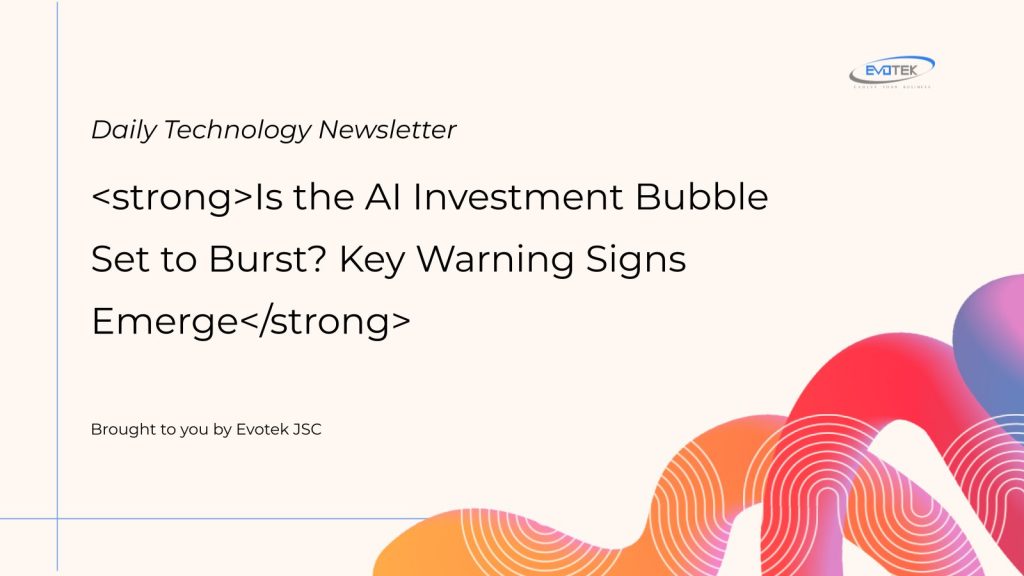The echoes of past tech market frenzies are growing louder, with many on Wall Street now questioning the sustainability of the current artificial intelligence (AI) boom. A significant recent development has fueled these concerns: a shock sell-off in major tech stocks followed by a sobering report from Massachusetts Institute of Technology (MIT) researchers.
This situation draws stark parallels to the dot-com bubble of 2000, when a similar surge in tech company valuations ended in a dramatic collapse, wiping out trillions of dollars. Now, the AI sector, which has seen unprecedented investment and enthusiasm, faces scrutiny as evidence mounts that many investments are failing to deliver tangible returns.
MIT Report Reveals Concerning AI Investment Returns
On Tuesday, the tech market experienced a sharp decline after an MIT study, conducted by its Nanda AI project, delivered a bombshell finding: the vast majority of enterprise investments in AI are yielding “zero return” for businesses. Despite an estimated $30-40 billion (£22-30 billion) poured into Generative AI solutions by companies, the report surprisingly revealed that 95% of organizations are seeing no measurable financial benefit.
The immediate market reaction was palpable. Shares in Nvidia, the $4 trillion chipmaker central to the AI revolution, dipped by 3.5%. Data analytics giant Palantir experienced an even steeper fall, losing 9% of its value. These findings are now seen by some as the potential catalyst that could prick the rapidly inflating tech stock market bubble, which has significantly augmented the value of U.S. equities.
The Unfulfilled Promise of AI & Investor Caution
Since the groundbreaking launch of ChatGPT in 2022, Silicon Valley executives have championed AI chatbots as transformative tools set to revolutionize the global economy. Billions have been spent on implementing AI tools for employees, with ambitious predictions of massive cost savings and efficiency gains.
However, the MIT report suggests that this promised AI revolution has largely stalled. After surveying 150 business leaders and 350 employees, researchers discovered that “just 5% of integrated AI pilots are extracting millions in value, while the vast majority remain stuck with no measurable P&L [profit and loss] impact.” Marko Kolanovic, formerly of JP Morgan, concisely remarked, “Sounds about right for a bubble.”
Further compounding these concerns, the study highlighted that half of all AI projects ultimately fail. While 80% of companies have explored AI technology, only 40% have actually deployed it. Moreover, “enterprise grade systems” are reportedly being “quietly rejected” by major businesses, with only 20% reaching the pilot stage and a mere 5% making it to full production.
Interestingly, the report noted that while many employees are eager to utilize AI, they often resort to consumer-grade products like ChatGPT on their own initiative, bypassing expensive or cumbersome corporate AI tools. This implies that while “AI is already transforming work,” it’s often occurring outside official, company-sanctioned channels, rendering corporate investments ineffective.
Industry Leaders Voice Concerns Amidst High Stakes
Even Sam Altman, CEO of OpenAI and a prime beneficiary of the AI boom, has acknowledged the potential for an overheated market. Despite reports of investors valuing his startup at $500 billion, Altman recently told reporters at a private dinner, “Are investors overexcited? My opinion is yes,” warning that some individuals stand to lose a “phenomenal amount of money.”
This sentiment resonates with fears among investors that SoftBank, the Japanese tech conglomerate with substantial investments in OpenAI, could be among those hit hardest. SoftBank’s shares consequently dropped by 7% on Tuesday.
Adding to the cautious mood, OpenAI’s much-anticipated ChatGPT-5 model recently underwhelmed many users, who found its improvements incremental at best and some even called for the return of earlier technology. This reception further casts doubt on the immediate revolutionary impact of cutting-edge AI.
The financial stakes are astronomically high. Morgan Stanley has projected data center investment to reach $3 trillion over the next three years, largely fueled by debt to power an expected surge in AI usage. Another recent forecast from the bank anticipated AI adding $16 trillion to the S&P 500 through substantial salary cost savings from job cuts and efficiencies. If the MIT report’s findings are accurate, such optimistic savings projections may prove unrealistic.
Even major tech players are adjusting their strategies. Meta, one of the biggest spenders on AI engineers, announced a reorganization of its AI division, which includes a downsizing of its headcount. This move by Meta founder Mark Zuckerberg, who has invested hundreds of millions into attracting top AI talent, signals a shift in approach amidst market jitters.
A Speed Bump or a Sign of Things to Come?
Despite these unsettling signs, the recent sell-off has not yet escalated into a full-blown market rout, with some analysts viewing it as merely a “speed bump.” Dan Ives, a technology analyst at Wedbush Securities, maintained an optimistic outlook, stating, “Skeptics of tech rally will be proven wrong (again).” Ives believes the “tech bull cycle will be well intact at least for another two to three years.”
All eyes now turn to Nvidia, the world’s most valuable company, as it prepares to report its latest results next week. Its earnings will provide crucial insights into the state of AI investment from some of the globe’s largest corporations. Nvidia has consistently surpassed Wall Street forecasts for profits and revenues over the past two years.
Nevertheless, the “unpleasant popping sound” that Barron’s once foretold for the internet bubble now reverberates as a cautionary whisper in the world of AI investment, leaving many to wonder if a significant correction is truly imminent.

 日本語
日本語 한국어
한국어 Tiếng Việt
Tiếng Việt 简体中文
简体中文